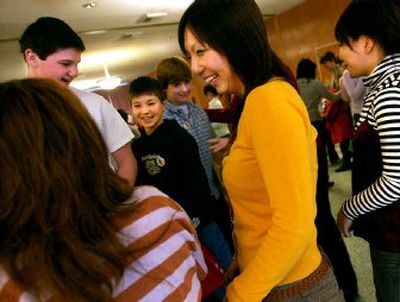Friendship exchange

There was a Spanish flamenco doll, twirling her red lace dress. There was a Japanese empress doll, seated before her golden screen. There was a Russian stacking doll, carved of wood and with rosettes painted on her cheeks.
But Mya Lynch, 5, thought her own doll was the best.
“It’s a doll, but I’m pretending it’s in my mommy’s tummy and it’s my little sister,” she said.
Mya and her classmates from Children’s Montessori Center celebrated Hina Matsuri, the 1,000-year-old Japanese festival of dolls, at the Mukogawa Fort Wright Institute and Japanese Cultural Center in Spokane on Thursday.
In Japan, grandparents give young girls a special set of dolls at the beginning of spring to ensure the girls’ happiness and prosperity. In Spokane, Hina Matsuri is a celebration of friendship between America and Japan, symbolized by the exchange of dolls.
Students from as far as Sandpoint gathered at the cultural center to receive the dolls and perform music and skits about friendship. Institute students told the history of the doll exchange, and the seventh-grade class from Sandpoint Middle School sang “Make New Friends,” which led to an auditoriumwide rendition of “It’s a Small World.”
It began in 1927 when an American missionary, Dr. Sidney Gulick, sent more than 12,000 blue-eyed dolls to Japan in time for the festival as a gesture of friendship between the children of the two countries. The Japanese in turn sent kimono-clad dolls to the United States. just before Christmas.
Mukogawa Women’s University in Nishinomiya, Japan – Spokane’s sister city – and its branch school, Mukogawa Fort Wright, rekindled the doll exchange 14 years ago.
This year, 47 Japanese dolls will be distributed to schools, day care centers and hospitals throughout the United States. Each doll is sent with an activity plan to teach children about Japanese culture.
The Spokane school is an educational organization for young Japanese women to learn English and American culture.
Many of the original friendship dolls were lost or destroyed during World War II, but several have survived.
One, Miss Tokushima, lives at the Northwest Museum of Arts & Culture, and was displayed at Thursday’s event. Her orange kimono is in perfect condition, and though she’s 79, there are no cracks on her smiling face.
“If these dolls could talk, they would tell us many interesting stories,” said Michiko Takaoka, director of the Japanese Cultural Center.